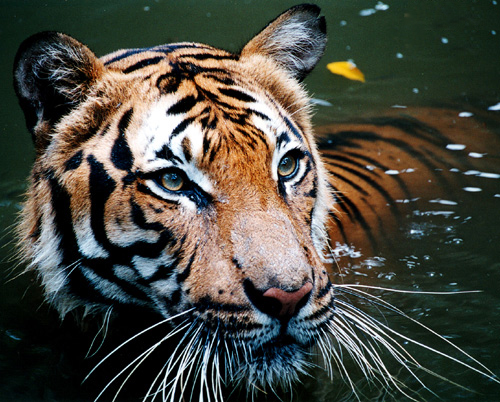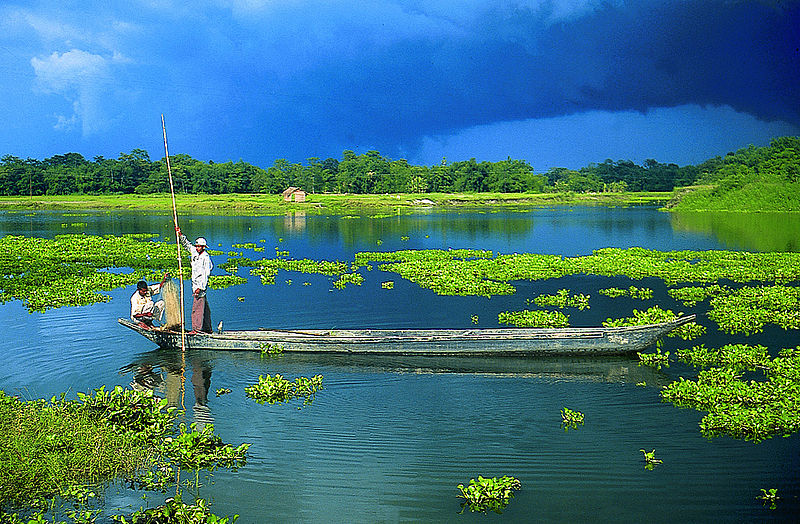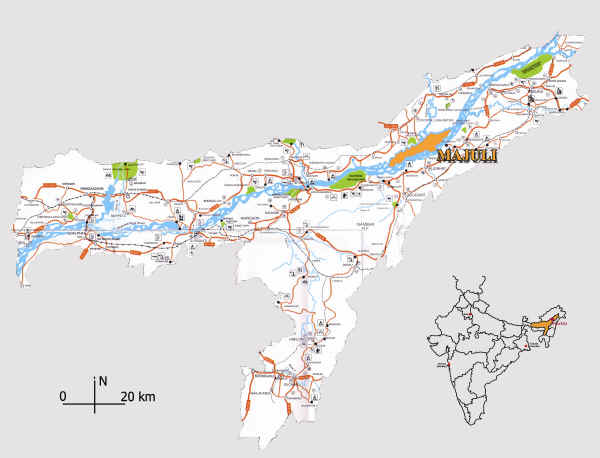 The tiger (Panthera tigris)
The tiger (Panthera tigris) is the
largest cat species, reaching a total body length of up to 3.3 m (11 ft) and
weighing up to 306 kg (670 lb). It is the third largest land carnivore (behind only the polar bear and the brown bear).
There are 9 subspecies of tiger, three of which are extinct. The Bengal tiger (P. t. tigris), The Indochinese tiger (P. t. corbetti), The Malayan tiger (P. t. jacksoni), The Sumatran tiger (P. t. sumatrae), The Siberian tiger (P. t. altaica), The South China tiger (P. t. amoyensis)
Extinct subspecies: The Bali tiger (P. t. balica), The Caspian tiger (P. t. virgata), The Javan tiger (P. t. sondaica)
The Bengal tiger (P. t. tigris), also called the Indian tiger or the Royal Bengal Tiger, lives in India, Nepal, Bhutan, and Bangladesh, and is the most common subspecies, with populations estimated at less than 2,500 adult individuals. In 2011, the total population of adult tigers was estimated at 1,520–1,909 in India, 440 in Bangladesh, 155 in Nepal and 75 in Bhutan. It lives in alluvial grasslands, subtropical and tropical rainforests, scrub forests, wet and dry deciduous forests, and mangroves. Male Bengal tigers have a total length, including the tail, of 270 to 310 cm (110 to 120 in), while females range from 240 to 265 cm (94 to 104 in). The weight of males range from 180 to 260 kg (400 to 570 lb), while that of the females range from 100 to 160 kg (220 to 350 lb). In northern India and Nepal, tigers tend to be of larger size. Males often average 235 kilograms (520 lb), while females average 141 kilograms (310 lb). In 1972, Project Tiger was founded in India aiming at ensuring a viable population of tigers in the country and preserving areas of biological importance as a natural heritage for the people. But the illicit demand for bones and body parts from wild tigers for use in traditional Chinese medicine is the reason for the unrelenting poaching pressure on tigers on the Indian subcontinent. Between 1994 and 2009, the Wildlife Protection Society of India has documented 893 cases of tigers killed in India, which is just a fraction of the actual poaching and illegal trade in tiger parts during those years. An area of special conservation interest lies in the Terai Arc Landscape in the Himalayan foothills of northern India and southern Nepal, where 11 protected areas comprising dry forest foothills and tall grass savannas harbor tigers in a landscape of 49,000 square kilometres (19,000 sq mi). The goals are to manage tigers as a single metapopulation, the dispersal of which between core refuges can help maintain genetic, demographic, and ecological integrity, and to ensure that species and habitat conservation becomes mainstreamed into the rural development agenda. In Nepal, a community-based tourism model has been developed with a strong emphasis on sharing benefits with local people and on the regeneration of degraded forests. The approach has been successful in reducing poaching, restoring habitats, and creating a local constituency for conservation.

Tigers range in size from the diminutive Sumatrans—females weigh between 165 and 242 pounds, and males weigh between 220 and 310 pounds—to the largest mainland tigers, such as Indians—females weigh between 220 and 352 pounds, and males weigh between 396 and 670 pounds. Total length ranges from seven to 11 feet.
Habitat:
The tiger's current distribution is a patchwork across Asia, from India to the Russian Far East. Tigers require large areas with forest cover, water, and suitable large ungulate prey such as deer and swine. With these three essentials, tigers can live from the tropical rainforests of Sumatra and Indochina to the temperate oak forest of the Amur River Valley in the Russian Far East.
Diet:
Tigers prey primarily on wild boar (Sus scrofa) and other swine, and medium to large deer such as chital (Axis axis), red deer (Cervus elaphus), and sambar (C. unicolor). Where they occur together, tigers also hunt gaur (Bos frontalis), a huge wild cattle. Tigers also kill domestic animals such as cows and goats, and occasionally kill people.
Hunting:
The tiger hunts alone, primarily between dusk and dawn, traveling six to 20 miles in a night in search of prey. A typical predatory sequence includes a slow, silent stalk until the tiger is 30 to 35 feet from the selected prey animal followed by a lightening fast rush to close the gap. The tiger grabs the animal in its forepaws, brings it to the ground, and finally kills the animal with a bite to the neck or throat. After dragging the carcass to a secluded spot, the tiger eats. A tiger eats 33 to 40 pounds of meat in an average night, and must kill about once per week. Catching a meal is not easy; a tiger is successful only once in ten to 20 hunts.
 The highest-scoring batting partnership in a one-day international is 331, by Sachin Tendulkar ( 186 not out ) and Rahul Dravid ( 153 ) for India v New Zealand at Lal Bahadur Shastri Stadium, Hyderabad, India, on 8 November 1999. They scored in the second wicket. The one day international match was against New Zealand, in the season of 1999.
The highest-scoring batting partnership in a one-day international is 331, by Sachin Tendulkar ( 186 not out ) and Rahul Dravid ( 153 ) for India v New Zealand at Lal Bahadur Shastri Stadium, Hyderabad, India, on 8 November 1999. They scored in the second wicket. The one day international match was against New Zealand, in the season of 1999.




 Later Shri Takulla indeed took the journey to New Delhi by the Rajdhani Express to arrive there well in time to see the Golden Jubilee Republic Day celebrations in January 2000. He was grateful to Allah for keeping him alive to see the destined day 27 years later.
Later Shri Takulla indeed took the journey to New Delhi by the Rajdhani Express to arrive there well in time to see the Golden Jubilee Republic Day celebrations in January 2000. He was grateful to Allah for keeping him alive to see the destined day 27 years later. Majuli is the largest riverine island in the world and is located within the Brahmaputra River, in the Indian state of Assam.
Majuli is the largest riverine island in the world and is located within the Brahmaputra River, in the Indian state of Assam.  A wetland, Mājuli is a hotspot for flora and fauna, harbouring many rare and endangered avifauna species including migratory birds that arrive in the winter season. Among the birds seen here are: the Greater Adjutant Stork, Pelican, Siberian Crane and the Whistling Teal. After dark wild geese and ducks fly in flocks to distant destinations. The island is almost pollution free owing to the lack of polluting industries and factories and also the chronic rainfall.
A wetland, Mājuli is a hotspot for flora and fauna, harbouring many rare and endangered avifauna species including migratory birds that arrive in the winter season. Among the birds seen here are: the Greater Adjutant Stork, Pelican, Siberian Crane and the Whistling Teal. After dark wild geese and ducks fly in flocks to distant destinations. The island is almost pollution free owing to the lack of polluting industries and factories and also the chronic rainfall. The tiger (Panthera tigris)
The tiger (Panthera tigris)